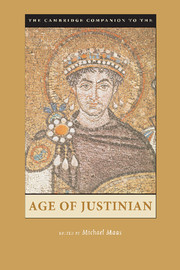14 - Art and Architecture in the Age of Justinian
from Part 3 - Literature and the Arts
Published online by Cambridge University Press: 28 May 2006
Summary
The reign of Justinian witnessed extraordinary levels of artistic activity, with the emperor himself an energetic patron of the arts. The court and clerical elites followed his lead, as did others throughout the empire and even beyond its borders in regions where the heritage of imperial Rome was still strong, especially in the former Roman provinces of western Europe. By Justinian’s time, Constantinople had become a major center for the arts, rivaling and even surpassing much older cities like Alexandria, Antioch, and Rome. In this chapter we will see how Justinian helped to shape artistic and architectural production in the capital and how this art is reflected in other regions of the empire and of the larger Mediterranean world.
Depictions of the emperor himself illustrate certain essential themes and concepts that characterized Justinianic art and are related to many developments observed in other chapters. Justinian appears as a triumphant conqueror, in accordance with conventions even older than the empire. He is often shown with features derived from the classical past, as ancient iconographic traditions continue to signal the age-old message of authority. Through such images, Justinian makes universal claims to sovereignty and control, aspects of imperial rule particularly emphasized during his reign. Perhaps most importantly, he is pictured as supported by Christ and supporting Christ. In the art of Justinian’s age, many strands of old Roman ideology and new religious expression are woven together in a way that is at once imperial and Christian to an extent never before realized. This Christian-imperial artistic matrix, characteristic of the Justinianic age, is fully in keeping with developments in law, political theory, philosophy, and military affairs.
- Type
- Chapter
- Information
- The Cambridge Companion to the Age of Justinian , pp. 343 - 375Publisher: Cambridge University PressPrint publication year: 2005
- 4
- Cited by



